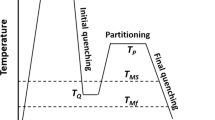Abstract
To improve safety in case of building fires, stricter building codes have been proposed requiring structural steels to maintain two-thirds of their room-temperature yield strength after exposure to 873 K (600 °C) for longer than 20 minutes. To address this need, we have designed lightly alloyed structural steels, employing computational thermodynamics in combination with fundamental principles of precipitation strengthening and its temperature dependence, precipitate stability, characterization by optical microscopy and atom probe tomography (APT), and mechanical testing at room and elevated temperatures. The design process resulted in low-carbon ferritic steels with small alloying additions of V, Nb, and Mo that maintain over 80 pct of room-temperature yield strength in compression, and nearly 70 pct in tension, after 2 hours of exposure at 873 K (600 °C). APT demonstrates the formation of nanoscale MX and M2X (where M = V + Nb + Mo and X = C + N) precipitates after exposure to 873 K (600 °C). The favorable high-temperature mechanical properties are discussed with a model of precipitation strengthening by detachment-stress-mediated dislocation pinning at nanoscale semi-coherent MX precipitates.









Similar content being viewed by others
References
T.J. MacGinley, Steel Structures: Practical Design Studies, second ed., CRC Press, 1998.
Y. Mizutani, K. Ishibashi, K. Yoshii, Y. Watanabe, R. Chijhwa, and Y. Yoshida: Shinnittetsu Giho, July 2004, pp. 38–44.
Standard Test Methods for Fire Tests of Building Construction and Materials, ASTM International, 2000.
4. D.B. Moore, T. Lennon, Prog. Struct. Eng. Mater., 1997, vol. 1, pp. 4-9.
M.G. Goode: Fire Protection of Structural Steel in High-Rise Buildings, NIST, 2004, p. 88.
AISC Specification for Structural Steel Buildings, American Institute of Steel Construction, 2010, p. 610.
7. W. Sha, F.S. Kelly, Z.X. Guo, J. Mater. Eng. Perform., 1999, vol. 8, pp. 606-612.
8. Y.D. Morozov, O.N. Chevskaya, G.A. Filippov, A.N. Muratov, Metallurgist, 2007, vol. 51, pp. 356-366.
9. W.-B. Lee, S.-G. Hong, C.-G. Park, S.-H. Park, Metall. Mater. Trans. A, 2002, vol. 33A, pp. 1689-1698.
10. M. Assefpour-Dezfuly, B.A. Hugaas, A. Brownrigg, Mater. Sci. Technol., vol 6, 1990, pp. 1210-1214.
11. R. Wan, F. Sun, L. Zhang, A. Shan, Mater. Design, 2012, vol. 36, pp. 227-232.
12. Z.-Y. Zhang, Q.-l. Yong, X.-J. Sun, Z.-D. Li, J.-Y. Kang, G.-D. Wang, J. Iron Steel Res. Int, 2015, vol. 22, pp. 337-343.
13. E. Arzt, D. Wilkinson, Acta Metall., 1986, vol. 34, pp. 1893-1898.
14. J. Rösler, E. Arzt, Acta Metall., 1988, vol. 36, pp. 1043-1051.
15. E. Arzt, J. Rösler, Acta Metall., 1988, vol. 36, pp. 1053-1060.
16. J. Rösler, E. Arzt, Acta Metall. Mater., 1990, vol. 38, pp. 671-683.
17. C. Wagner, Z. Elektrochemie, 1961, vol. 65, pp. 581-591.
18. I. Lifshitz, V. Slyozov, Phys. Chem. Sol., 1961, vol. 19, pp. 35-50.
19. C. Enloe, K. Findley, C. Parish, M. Miller, B. De Cooman, J. Speer, Scripta mater., 2013, vol. 68, pp. 55-58.
20. P. Maugis, M. Gouné, Acta Mater., 2005, vol 53, pp. 3359-3367.
21. M. Perez, E. Courtois, D. Acevedo, T. Epicier, P. Maugis, Phil. Mag. Lett., 2007, vol. 87, pp. 645-656.
22. H.-J. Kestenbach, E.V. Morales, Acta. Micro., 1998, vol. 7, pp. 22-33.
23. Z.-G. Yang, M. Enomoto, Mater. Sci. Eng. A, 2002, vol. 332, pp. 184-192.
24. E.K. Storms, C.P. Kempter, J. Chem. Phys., 1965, vol. 42, pg. 2043.
25. E.K. Storms, N.H. Krikorian, J. Chem. Phys., 1959, vol. 63, pp. 1747-1749.
26. C.P. Kempter, E.K. Storms, J. Less-Common Met., 1967, vol. 13, pp. 443-447.
27. K. Miyata, T. Kushida, T. Omura, Y. Komizo, Metall. and Mat. Trans. A, 2003, vol. 34, pp. 1565-1573.
28. D.J. Larson, T.J. Prosa, R.M. Ulfig, B.P. Geiser, T.F. Kelly, Local Electrode Atom Probe Tomography: A User’s Guide. Springer, New York, (2013).
Standard Test Methods of Compression Testing of Metallic Materials at Room Temperature, ASTM International, 2009.
Standard Practice for Compression Tests of Metallic Materials at Elevated Temperatures with Conventional or Rapid Heating Rates and Strain Rates, ASTM International, 2000.
Standard Test Methods for Elevated Temperature Tension Tests of Metallic Materials, ASTM International, 2009.
M. Boccalini Jr. and A. Sinatora: 6th International Tooling Conference Proceedings, 2002, pp. 509–24.
H.J. Frost, M.F. Ashby, Deformation-mechanism maps: the plasticity and creep of metals and ceramics, Pergamon Press, 1982.
Acknowledgments
The authors would like to acknowledge the NSF CMMI Division [Grant Numbers NSF-CMMI-1130000 and CMMI-1462850] for providing funding for this research and Nucor for supplying one of the alloys gratis used in this research. This work made use of the MatCI Facility which receives support from the MRSEC Program (NSF DMR-1720139) of the Materials Research Center at Northwestern University. APT was performed at the Northwestern University Center for Atom Probe Tomography (NUCAPT). The local-electrode atom probe tomograph at NUCAPT was acquired and upgraded with equipment grants from the MRI Program of the National Science Foundation (NSF DMR-0420532) and the DURIP Program of the Office of Naval Research (N00014-0400798, N00014-0610539, N00014-0910781, N00014-1712870). NUCAPT received support from the MRSEC Program (NSF DMR-1720139) at the Materials Research Center, the SHyNE Resource (NSF ECCS-1542205), and the Institute for Sustainability and Energy at Northwestern (ISEN).
Author information
Authors and Affiliations
Corresponding author
Additional information
Manuscript submitted January 2, 2018.
Rights and permissions
About this article
Cite this article
Gross, C.T., Isheim, D., Vaynman, S. et al. Design and Development of Lightly Alloyed Ferritic Fire-Resistant Structural Steels. Metall Mater Trans A 50, 209–219 (2019). https://doi.org/10.1007/s11661-018-4985-5
Received:
Published:
Issue Date:
DOI: https://doi.org/10.1007/s11661-018-4985-5




